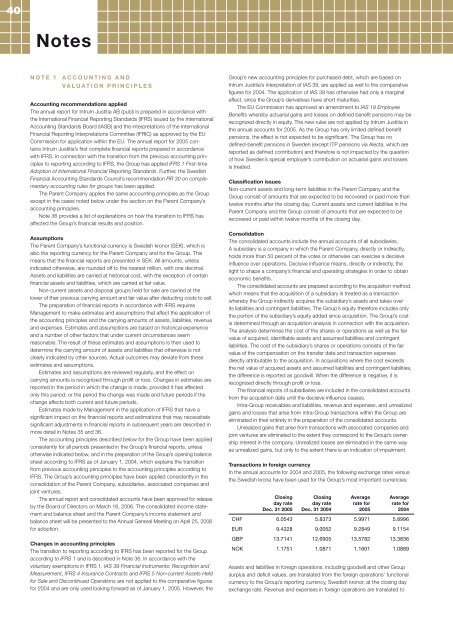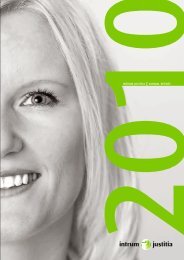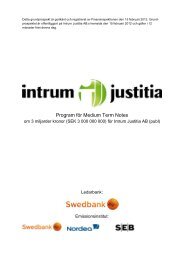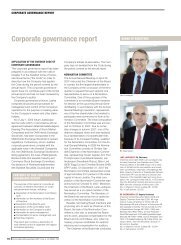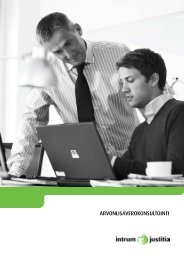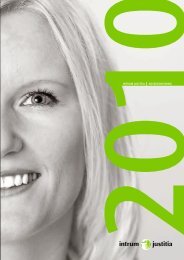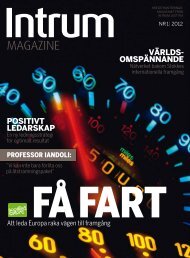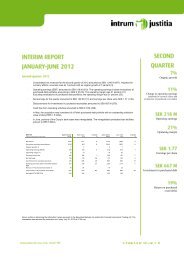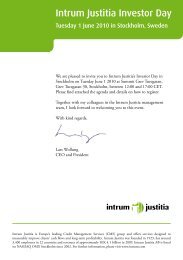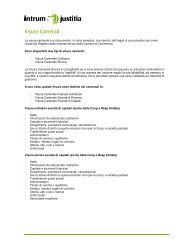Create successful ePaper yourself
Turn your PDF publications into a flip-book with our unique Google optimized e-Paper software.
40<br />
Notes<br />
NOTE 1 ACCOUNTING AND<br />
VALUATION PRINCIPLES<br />
Accounting recommendations applied<br />
The annual report for <strong>Intrum</strong> <strong>Justitia</strong> AB (publ) is prepared in accordance with<br />
the International Financial Reporting Standards (IFRS) issued by the International<br />
Accounting Standards Board (IASB) and the interpretations of the International<br />
Financial Reporting Interpretations Committee (IFRIC) as approved by the EU<br />
Commission for application within the EU. The annual report for 2005 contains<br />
<strong>Intrum</strong> <strong>Justitia</strong>’s fi rst complete fi nancial reports prepared in accordance<br />
with IFRS. In connection with the transition from the previous accounting principles<br />
to reporting according to IFRS, the Group has applied IFRS 1 First-time<br />
Adoption of International Financial Reporting Standards. Further, the Swedish<br />
Financial Accounting Standards Council’s recommendation RR 30 on complementary<br />
accounting rules for groups has been applied.<br />
The Parent Company applies the same accounting principles as the Group<br />
except in the cases noted below under the section on the Parent Company’s<br />
accounting principles.<br />
Note 36 provides a list of explanations on how the transition to IFRS has<br />
affected the Group’s fi nancial results and position.<br />
Assumptions<br />
The Parent Company’s functional currency is Swedish kronor (SEK), which is<br />
also the reporting currency for the Parent Company and for the Group. This<br />
means that the fi nancial reports are presented in SEK. All amounts, unless<br />
indicated otherwise, are rounded off to the nearest million, with one decimal.<br />
Assets and liabilities are carried at historical cost, with the exception of certain<br />
fi nancial assets and liabilities, which are carried at fair value.<br />
Non-current assets and disposal groups held for sale are carried at the<br />
lower of their previous carrying amount and fair value after deducting costs to sell.<br />
The preparation of fi nancial reports in accordance with IFRS requires<br />
Management to make estimates and assumptions that affect the application of<br />
the accounting principles and the carrying amounts of assets, liabilities, revenue<br />
and expenses. Estimates and assumptions are based on historical experience<br />
and a number of other factors that under current circumstances seem<br />
reasonable. The result of these estimates and assumptions is then used to<br />
determine the carrying amount of assets and liabilities that otherwise is not<br />
clearly indicated by other sources. Actual outcomes may deviate from these<br />
estimates and assumptions.<br />
Estimates and assumptions are reviewed regularly, and the effect on<br />
carrying amounts is recognized through profi t or loss. Changes in estimates are<br />
reported in the period in which the change is made, provided it has affected<br />
only this period, or the period the change was made and future periods if the<br />
change affects both current and future periods.<br />
Estimates made by Management in the application of IFRS that have a<br />
signifi cant impact on the fi nancial reports and estimations that may necessitate<br />
signifi cant adjustments in fi nancial reports in subsequent years are described in<br />
more detail in Notes 35 and 36.<br />
The accounting principles described below for the Group have been applied<br />
consistently for all periods presented in the Group’s fi nancial reports, unless<br />
otherwise indicated below, and in the preparation of the Group’s opening balance<br />
sheet according to IFRS as of January 1, 2004, which explains the transition<br />
from previous accounting principles to the accounting principles according to<br />
IFRS. The Group’s accounting principles have been applied consistently in the<br />
consolidation of the Parent Company, subsidiaries, associated companies and<br />
joint ventures.<br />
The annual report and consolidated accounts have been approved for release<br />
by the Board of Directors on March 16, 2006. The consolidated income statement<br />
and balance sheet and the Parent Company’s income statement and<br />
balance sheet will be presented to the Annual General Meeting on April 25, 2006<br />
for adoption.<br />
Changes in accounting principles<br />
The transition to reporting according to IFRS has been reported for the Group<br />
according to IFRS 1 and is described in Note 36. In accordance with the<br />
voluntary exemptions in IFRS 1, IAS 39 Financial Instruments: Recognition and<br />
Measurement, IFRS 4 Insurance Contracts and IFRS 5 Non-current Assets Held<br />
for Sale and Discontinued Operations are not applied to the comparative fi gures<br />
for 2004 and are only used looking forward as of January 1, 2005. However, the<br />
Group’s new accounting principles for purchased debt, which are based on<br />
<strong>Intrum</strong> <strong>Justitia</strong>’s interpretation of IAS 39, are applied as well to the comparative<br />
fi gures for 2004. The application of IAS 39 has otherwise had only a marginal<br />
effect, since the Group’s derivatives have short maturities.<br />
The EU Commission has approved an amendment to IAS 19 Employee<br />
Benefi ts whereby actuarial gains and losses on defi ned benefi t pensions may be<br />
recognized directly in equity. The new rules are not applied by <strong>Intrum</strong> <strong>Justitia</strong> in<br />
the annual accounts for 2005. As the Group has only limited defi ned benefi t<br />
pensions, the effect is not expected to be signifi cant. The Group has no<br />
defi ned-benefi t pensions in Sweden (except ITP pensions via Alecta, which are<br />
reported as defi ned contribution) and therefore is not impacted by the question<br />
of how Sweden’s special employer’s contribution on actuarial gains and losses<br />
is treated.<br />
Classifi cation issues<br />
Non-current assets and long-term liabilities in the Parent Company and the<br />
Group consist of amounts that are expected to be recovered or paid more than<br />
twelve months after the closing day. Current assets and current liabilities in the<br />
Parent Company and the Group consist of amounts that are expected to be<br />
recovered or paid within twelve months of the closing day.<br />
Consolidation<br />
The consolidated accounts include the annual accounts of all subsidiaries.<br />
A subsidiary is a company in which the Parent Company, directly or indirectly,<br />
holds more than 50 percent of the votes or otherwise can exercise a decisive<br />
infl uence over operations. Decisive infl uence means, directly or indirectly, the<br />
right to shape a company’s fi nancial and operating strategies in order to obtain<br />
economic benefi ts.<br />
The consolidated accounts are prepared according to the acquisition method,<br />
which means that the acquisition of a subsidiary is treated as a transaction<br />
whereby the Group indirectly acquires the subsidiary’s assets and takes over<br />
its liabilities and contingent liabilities. The Group’s equity therefore includes only<br />
the portion of the subsidiary’s equity added since acquisition. The Group’s cost<br />
is determined through an acquisition analysis in connection with the acquisition.<br />
The analysis determines the cost of the shares or operations as well as the fair<br />
value of acquired, identifi able assets and assumed liabilities and contingent<br />
liabilities. The cost of the subsidiary’s shares or operations consists of the fair<br />
value of the compensation on the transfer date and transaction expenses<br />
directly attributable to the acquisition. In acquisitions where the cost exceeds<br />
the net value of acquired assets and assumed liabilities and contingent liabilities,<br />
the difference is reported as goodwill. When the difference is negative, it is<br />
recognized directly through profi t or loss.<br />
The fi nancial reports of subsidiaries are included in the consolidated accounts<br />
from the acquisition date until the decisive infl uence ceases.<br />
Intra-Group receivables and liabilities, revenue and expenses, and unrealized<br />
gains and losses that arise from intra-Group transactions within the Group are<br />
eliminated in their entirety in the preparation of the consolidated accounts.<br />
Unrealized gains that arise from transactions with associated companies and<br />
joint ventures are eliminated to the extent they correspond to the Group’s ownership<br />
interest in the company. Unrealized losses are eliminated in the same way<br />
as unrealized gains, but only to the extent there is an indication of impairment.<br />
Transactions in foreign currency<br />
In the annual accounts for 2004 and 2005, the following exchange rates versus<br />
the Swedish krona have been used for the Group’s most important currencies:<br />
Closing<br />
day rate<br />
Dec. 31 2005<br />
Closing<br />
day rate<br />
Dec. 31 2004<br />
Average<br />
rate for<br />
2005<br />
Average<br />
rate for<br />
2004<br />
CHF 6.0543 5.8373 5.9971 5.8996<br />
EUR 9.4228 9.0052 9.2849 9.1154<br />
GBP 13.7141 12.6905 13.5782 13.3836<br />
NOK 1.1751 1.0871 1.1601 1.0889<br />
Assets and liabilities in foreign operations, including goodwill and other Group<br />
surplus and defi cit values, are translated from the foreign operations’ functional<br />
currency to the Group’s reporting currency, Swedish kronor, at the closing day<br />
exchange rate. Revenue and expenses in foreign operations are translated to


